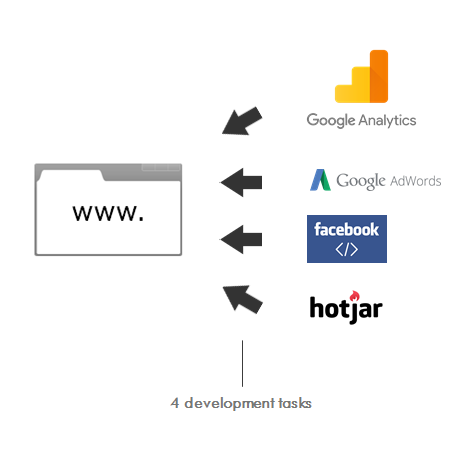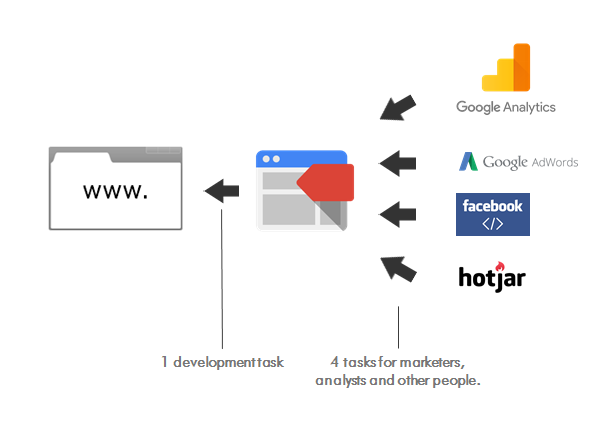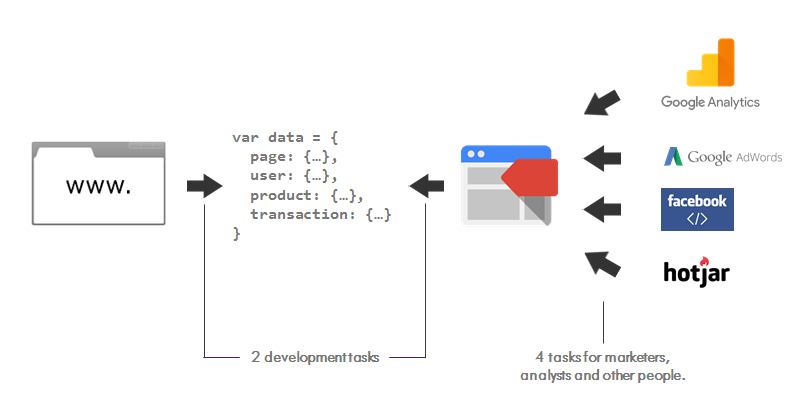We’ve been working with tag managers for about three years now, but we still notice some unclarity about what a tag manager is amongst both colleagues and clients alike. Let’s clarify things.
What are tags?
First things first: what does tag in tag manager stand for? Tags are generally code snippets that you’ll want to place on your website for various reasons:
- Analytics: for tracking website visitors (e.g. Google Analytics or Adobe Analytics).
- Conversion tags: track conversions in an advertising platform (e.g. Google Adwords, AppNexus).
- Audience builders for remarketing: build audiences based on website behaviour for remarketing (e.g. Google Remarketing Lists, Facebook Audiences).
- Research: generate click maps (heatmaps), record user behaviour, ask questions (e.g. Hotjar, Mouseflow, Qualaroo).
They generally come in two flavours:
- JavaScript tags.
- HTML image tags (generally an alternative to the JavaScript tracker when JavaScript is disabled).
Say you’ll want to have a set of these tools on your website:
- Google Analytics.
- Google AdWords conversion tracking.
- Facebook audience builder.
- Hotjar.
Without a tag manager, your developers will need to implement all 4 tags individually:

If you don’t use a tag manager, developers need to implement 4 tags separately.
And this only takes basic all pages tags into account. You’ll probably want to track special pages, like product, basket and purchase pages in a separate, more detailed way (e.g. add total revenue to tags on the purchase page). For each extra tracking update, you’ll need your developers. This reduces the speed with which you can change or add tags.
Tag management to the rescue
A tag management systems (TMS) solves this issue. With a tag manager, you’ll only implement one tag for your entire website: the tag manager. This tag allows you to control other tags from an interface:

With a tag manager, developers will implement only one tag: the tag manager. Marketers, Analysts and other people can add all the tags they need themselves.
Do you want to add Google Analytics? Just add the tag from the GA interface to your tag manager and you’re done. Need a conversion tag on the basket page to measure ad performance? Add a tag with a basket specific load rule and you’re done. The benefit is clear: you put the people who use the tags (web analysts, marketers etc.) in control of those very same tags.
The power of the data layer
If you’ve installed a tag manager, you can load tags based on basic rules such as:
- Page URL.
- Timers.
- Scroll depth.
Though these options are great, the potential of your TMS can be improved. What if you could add tags based on the value of a basket, add revenue to your conversion tracking or show a pop-up question for a specific set of products? That’s what a data layer is for:

With a tag manager and data layer, you’ll increase the data you can use for both your tags load rules and the information you send tags themselves.
It’s a layer that transforms website data, both visible and invisible, to a readable data object for your TMS. It can contain different types of information:
- Page data, e.g. a virtual page path or a page type.
- User data, e.g. a user id or user value.
- Product data, e.g. names, prices and SKUs.
- E-commerce data, e.g. total revenue of a transaction.
By adding this data on your website, you’ll increase the options you have for both placing tags and measuring the data within those tags:
- Measure advance e-commerce data with Google Analytics Enhance E-commerce.
- Add actual revenue of a conversion to your Adwords Conversion Tracking.
- Add product information to your Facebook audiences for remarketing.
- Trigger a Hotjar poll when a user has high margin product in the basket and tries to leave the website.
- Apply cross-device measurement with the help of user IDs.
These are just some example of what you can do with a good data layer in place.
Responsibility for the data layer
I sometimes get the question about who’s responsible for the data layer. People sometimes assume that we create it via the tag manager as well. Sadly, that’s not the case. Developers of the website make it available for the tag manager. They make sure that both visible data (e.g. total revenue on a transaction page) and invisible data (e.g. a user id, or a page type) are added to the data layer. An agency that manages your tags will only leverage the data layer.
Advanced implementations beat basic implementations
If you brief a tag manager implementation, I strongly suggest you to brief a very advanced and complete one. It’s better to have data in there that you don’t need right now. Not having that data will make you dependent from updates by your developers once you do need it.
The challenge
The biggest challenge is to convince your clients and other stakeholders of the value of a TMS with a well-defined data layer. They might not get the benefits as some of the tags you’ll be moving to the TMS are already running on the site. But as soon as you have it in place, both you and the client will greatly benefit from it. It’ll put marketers and analysts in control of their tags, which increases the flexibility and speed of their day-to-day business.
In the end, it’ll make both you, your colleagues and your client happier people.







Leave a Reply
You must be logged in to post a comment.